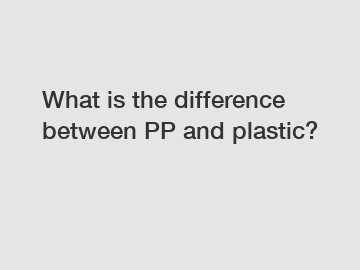What is the difference between PP and plastic?
What is the difference between PP and plastic?
Plastic has become an indispensable part of our daily lives, but it often raises questions about its environmental impact and various types. One common query is about the difference between PP (polypropylene) and other plastics. In this article, we will delve into the dissimilarities between PP and plastic, shedding light on their characteristics, uses, recycling processes, and environmental considerations.
1. Understanding the Basics:

- Polypropylene is a type of thermoplastic polymer.
- Plastic is a broad term encompassing a range of synthetic or semi-synthetic materials made from polymers.
- PP falls under the category of plastic, but not all plastics are made from polypropylene.
2. Composition and Properties:
- PP is made from propylene monomers, whereas plastic can be composed of various materials, including polyethylene, polystyrene, polyvinyl chloride (PVC), and more.
- Polypropylene is known for its high melting point, chemical resistance, toughness, and excellent balance between rigidity and flexibility. These properties make PP ideal for manufacturing durable products such as food containers, automotive components, and household items.
- Plastics can have diverse properties depending on their composition and additives. For instance, polyethylene terephthalate (PET) is commonly used in the production of bottles due to its clarity, lightweight nature, and recyclability.
3. Applications:
- PP finds extensive applications in multiple industries, from packaging and textiles to automotive and healthcare. Its lightweight nature, resistance to chemical solvents, and durability make it a preferred choice for a wide range of products.
- Different plastics are used in various applications too. For example, high-density polyethylene (HDPE) is commonly employed for making milk jugs, while PVC is often used in plumbing pipes and vinyl records.
4. Recycling:
- PP is one of the most widely recycled plastics due to its versatile nature. The recycling process involves sorting, cleaning, melting, and reforming PP into new products.
- Plastic recycling, on the other hand, varies based on the type of plastic. Not all plastics have the same recycling capabilities, and some may not be recycled at all due to limited infrastructure or lack of demand.
5. Environmental Considerations:
- One advantage of PP is its lower environmental impact compared to many other plastics. It has a relatively lower carbon footprint during production and recycling processes.
- Plastic waste, if not properly managed, poses significant environmental challenges. It can take hundreds of years to decompose, polluting landfills and oceans. Recycling and reducing plastic usage are essential to mitigate these issues.
In conclusion, PP, as a specific type of plastic, distinguishes itself through its composition, properties, applications, and recycling capabilities. While polypropylene offers durability, chemical resistance, and a favorable environmental footprint, it is important to consider the broader context of plastics and their impact on the planet. By understanding the unique characteristics of different plastics, we can make informed choices to reduce plastic pollution and build a more sustainable future.
For more Hot Sale Cnc Plastic Machined Parts Supplier, Polyethylene Wear-Resistant Guide China Manufacturer, Plastic Cnc Machininginformation, please contact us. We will provide professional answers.
45
0
0

Comments
All Comments (0)